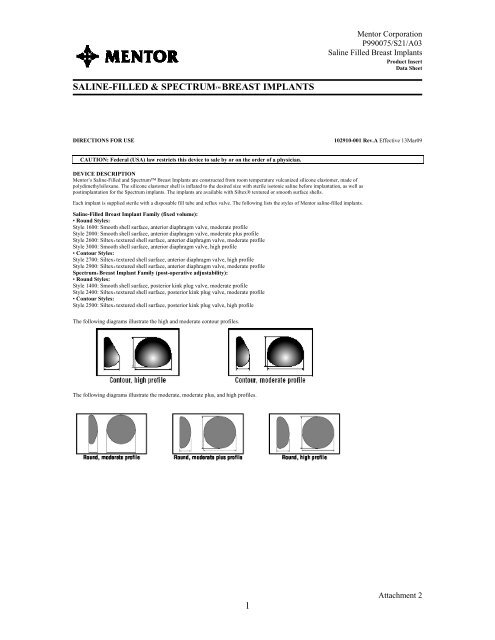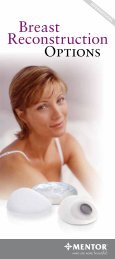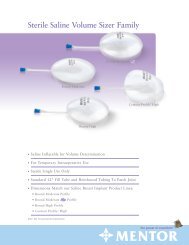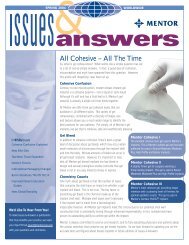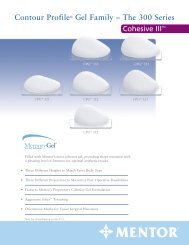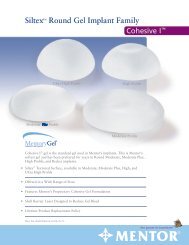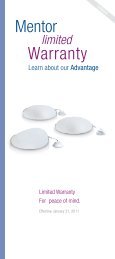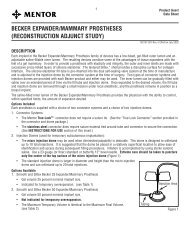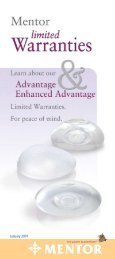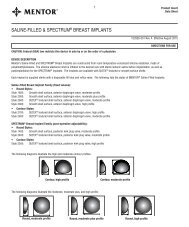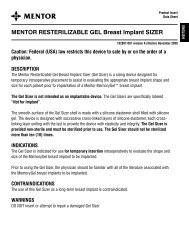Saline-Filled and Spectrum⢠Breast Implants - Mentor
Saline-Filled and Spectrum⢠Breast Implants - Mentor
Saline-Filled and Spectrum⢠Breast Implants - Mentor
You also want an ePaper? Increase the reach of your titles
YUMPU automatically turns print PDFs into web optimized ePapers that Google loves.
<strong>Mentor</strong> Corporation<br />
P990075/S21/A03<br />
<strong>Saline</strong> <strong>Filled</strong> <strong>Breast</strong> <strong>Implants</strong><br />
Product Insert<br />
Data Sheet<br />
SALINE-FILLED & SPECTRUM BREAST IMPLANTS<br />
DIRECTIONS FOR USE<br />
102910-001 Rev.A Effective 13Mar09<br />
CAUTION: Federal (USA) law restricts this device to sale by or on the order of a physician.<br />
DEVICE DESCRIPTION<br />
<strong>Mentor</strong>’s <strong>Saline</strong>-<strong>Filled</strong> <strong>and</strong> Spectrum <strong>Breast</strong> <strong>Implants</strong> are constructed from room temperature vulcanized silicone elastomer, made of<br />
polydimethylsiloxane. The silicone elastomer shell is inflated to the desired size with sterile isotonic saline before implantation, as well as<br />
postimplantation for the Spectrum implants. The implants are available with Siltex® textured or smooth surface shells.<br />
Each implant is supplied sterile with a disposable fill tube <strong>and</strong> reflux valve. The following lists the styles of <strong>Mentor</strong> saline-filled implants.<br />
<strong>Saline</strong>-<strong>Filled</strong> <strong>Breast</strong> Implant Family (fixed volume):<br />
• Round Styles:<br />
Style 1600: Smooth shell surface, anterior diaphragm valve, moderate profile<br />
Style 2000: Smooth shell surface, anterior diaphragm valve, moderate plus profile<br />
Style 2600: Siltex® textured shell surface, anterior diaphragm valve, moderate profile<br />
Style 3000: Smooth shell surface, anterior diaphragm valve, high profile<br />
• Contour Styles:<br />
Style 2700: Siltex® textured shell surface, anterior diaphragm valve, high profile<br />
Style 2900: Siltex® textured shell surface, anterior diaphragm valve, moderate profile<br />
Spectrum® <strong>Breast</strong> Implant Family (post-operative adjustability):<br />
• Round Styles:<br />
Style 1400: Smooth shell surface, posterior kink plug valve, moderate profile<br />
Style 2400: Siltex® textured shell surface, posterior kink plug valve, moderate profile<br />
• Contour Styles:<br />
Style 2500: Siltex® textured shell surface, posterior kink plug valve, high profile<br />
The following diagrams illustrate the high <strong>and</strong> moderate contour profiles.<br />
The following diagrams illustrate the moderate, moderate plus, <strong>and</strong> high profiles.<br />
1<br />
Attachment 2
<strong>Mentor</strong> Corporation<br />
P990075/S21/A03<br />
<strong>Saline</strong> <strong>Filled</strong> <strong>Breast</strong> <strong>Implants</strong><br />
INDICATIONS<br />
<strong>Breast</strong> implants are indicated for females for the following indications:<br />
• <strong>Breast</strong> Augmentation. A woman must be at least 18 years old for breast augmentation.<br />
• <strong>Breast</strong> Reconstruction.<br />
CONTRAINDICATIONS<br />
Patient Groups in which the product is contraindicated:<br />
• Active infection anywhere in the body.<br />
• Existing malignant or pre-malignant breast cancer without adequate treatment.<br />
• Augmentation in women who are currently pregnant or nursing.<br />
Surgical Practices in which product use is contraindicated due to compromise of product integrity:<br />
• Stacking of implants: Do not place more than one implant per breast pocket.<br />
• Do not make injections into the implant.<br />
• Do not alter the implant shell or valve.<br />
• Do not place drugs or substances inside the implant other than sterile saline for injection.<br />
• Do not allow the implant to come in contact with Betadine®.*<br />
WARNINGS<br />
1. Closed Capsulotomy<br />
DO NOT treat capsular contracture by forceful external compression, which will likely result in implant damage, deflation, folds, <strong>and</strong>/or hematoma.<br />
Capsule firmness must not be treated by overexpansion of the device.<br />
2. Reuse<br />
<strong>Breast</strong> implants are intended for single use only. Do not resterilize.<br />
3. Avoiding Damage during Surgery<br />
• Care should be taken not to damage the prosthesis with surgical instruments.<br />
• Do not insert or attempt to repair a damaged prosthesis.<br />
• Use care in subsequent procedures such as open capsulotomy, breast pocket revision, hematoma/seroma aspiration, <strong>and</strong> biopsy/lumpectomy to avoid<br />
damage to the implant shell or valve.<br />
• Do not contact the implant with disposable, capacitor-type cautery devices.<br />
4. Proper Filling<br />
Follow the recommendation on the product data sheet for fill volume; do not overfill or underfill the implant.<br />
Underfilled prostheses may buckle, fold or wrinkle, causing crease/fold failure of the device, <strong>and</strong> subsequent deflation can occur.<br />
Additionally, inflation beyond the maximum volume can also cause crease/fold failure <strong>and</strong> deflation.<br />
5. Microwave Diathermy<br />
The use of microwave diathermy in patients with breast implants is not recommended, as it has been reported to cause tissue necrosis, skin erosion, <strong>and</strong><br />
extrusion of the implant.<br />
6. Do not use endoscopic placement or periumbilical approach in placement of the implant.<br />
PRECAUTIONS<br />
1. Specific Populations<br />
Safety & Effectiveness has not been established in patients with:<br />
• Autoimmune diseases such as lupus <strong>and</strong> scleroderma.<br />
• A compromised immune system (e.g., currently receiving immunosuppressive therapy).<br />
• Patients with conditions or medications which interfere with wound healing ability (such as poorly controlled diabetes) or blood clotting (such as<br />
concurrent coumadin therapy).<br />
• Reduced blood supply to breast tissue.<br />
*Betadine® is a registered trademark of the Purdue Frederic Company.<br />
2<br />
Attachment 2
<strong>Mentor</strong> Corporation<br />
P990075/S21/A03<br />
<strong>Saline</strong> <strong>Filled</strong> <strong>Breast</strong> <strong>Implants</strong><br />
2. Mammography<br />
<strong>Breast</strong> implants may complicate the interpretation of mammographic images by obscuring underlying breast tissue <strong>and</strong>/or by compressing overlying<br />
tissue. Accredited mammography centers <strong>and</strong> use of displacement techniques are needed to adequately visualize breast tissue in the implanted breast.<br />
Presurgical mammography with a follow-up mammogram 6 months to 1 year following surgery may be performed to establish a baseline for future<br />
routine mammography.<br />
3. Radiation to the <strong>Breast</strong><br />
<strong>Mentor</strong> has not tested the in vivo effects of radiation therapy in patients who have breast implants. The literature suggests that radiation therapy may<br />
increase the likelihood of capsular contracture, necrosis, <strong>and</strong> extrusion.<br />
4. Long-Term Effects<br />
<strong>Mentor</strong> has monitored the long-term risks of implant rupture, reoperation, implant removal, <strong>and</strong> capsular contracture out through 10 years.<br />
5. Instructions to Patients:<br />
• Reoperation – Patients should be advised that additional surgery to their breast <strong>and</strong>/or implant will be likely over the course of their life.<br />
• Explantation – Patients should be advised that implants are not considered lifetime devices <strong>and</strong> they will likely undergo implant removal, with or<br />
without replacement, over the course of their life. Patients should also be advised that the changes to their breast following explantation are<br />
irreversible.<br />
• Mammography – Patients should be instructed to inform their mammographers about the presence of their implants.<br />
• Lactation – Patients should be advised that breast implants may interfere with the ability to successfully breast feed.<br />
• <strong>Breast</strong> Examination Techniques - Patients should be instructed to perform breast self-examinations monthly <strong>and</strong> be shown how to distinguish the<br />
implant from their breast tissue. The patient should be instructed not to manipulate (i.e., squeeze) the valve excessively, which may cause valve<br />
leakage.<br />
ADVERSE EVENTS<br />
<strong>Mentor</strong> Corporation implants were evaluated in two prospective open label clinical studies: the Large Simple Trial (LST, which involved 2385 patients)<br />
<strong>and</strong> the <strong>Saline</strong> Prospective Study (SPS, which involved 1680 patients). The cumulative Kaplan-Meier risk of first occurrence of adverse events (<strong>and</strong> 95%<br />
confidence interval) reported in greater than 1% of patients is shown in Tables 1 <strong>and</strong> 2 on a by patient basis based on indication.<br />
Table 1. LST: 1-Year Cumulative First Occurrence Kaplan-Meier Adverse Event Risk Rates (95% Confidence Interval), By Patient.<br />
Complication Augmentation Reconstruction Revision<br />
Rate (%) (95% CI) Rate (%) (95% CI) Rate (%) (95% CI)<br />
Capsular Contracture III/IV 4.6% (3.5, 5.7) 29.0% (20.1, 37.8) 14.5% (8.9, 20.1)<br />
Implant Removal with or without<br />
3.6% (2.6, 4.5) 9.5% (3.8, 15.3) 6.0% (1.9, 10.2)<br />
Replacement<br />
Leakage/Deflation 1.4% (0.7, 2.0) NA* NA* 2.3% (0.0, 4.8)<br />
Infection 0.9% (0.5, 1.4) NA* NA* NA* NA*<br />
*Insufficient numbers of patients to calculate a Kaplan-Meier risk rate.<br />
3<br />
Attachment 2
<strong>Mentor</strong> Corporation<br />
P990075/S21/A03<br />
<strong>Saline</strong> <strong>Filled</strong> <strong>Breast</strong> <strong>Implants</strong><br />
Table 2. SPS: 3-Year Cumulative First Occurrence Kaplan-Meier Adverse Event Risk Rates (95% Confidence Interval), By Patient.<br />
Augmentation<br />
Reconstruction<br />
Complication<br />
By Patient<br />
By Patient<br />
N=1264 N=416<br />
Rate (%) (95% CI) Rate (%) (95% CI)<br />
Wrinkling 20.8% (18.4, 23.2) 20.0% (15.4, 24.5)<br />
Reoperation 13.2% (11.2, 15.2) 40.1% (35.0, 45.3)<br />
Loss of Nipple Sensation 10.2% (8.4, 12.0) 34.5 % (29.0, 40.0)<br />
Capsular Contracture III/IV<br />
or grade unknown<br />
9.0% (7.3, 10.7) 30.0% (24.5, 34.8)<br />
Implant Removal for Any<br />
Reason<br />
8.1% (6.5, 9.7) 26.8% (22.2, 31.5)<br />
Asymmetry 6.7% (5.2, 8.1) 27.9% (23.0, 32.7)<br />
<strong>Breast</strong> Pain 5.1% (3.8, 6.5) 17.2% (12.5, 21.9)<br />
Intense Nipple Sensitivity 4.8% (3.5, 6.1)
<strong>Mentor</strong> Corporation<br />
P990075/S21/A03<br />
<strong>Saline</strong> <strong>Filled</strong> <strong>Breast</strong> <strong>Implants</strong><br />
Table 3a. SPS: Types of Additional Surgical Procedures through 3 Years for Augmentation<br />
Of the 1264 augmentation patients, there were 147 (11.6%) who underwent at least one additional surgical procedure over the 3 years of follow-up in the<br />
SPS. A total of 358 additional surgical procedures were performed in augmentation patients over the 3 years of the SPS. The types of additional surgical<br />
procedures are shown below based on the number of procedures.<br />
Types of Additional Surgical Procedures for<br />
N = 358 procedures<br />
Augmentation n %<br />
Implant Removal with Replacement 116 32%<br />
Capsule Related 1 77 22%<br />
Scar or Wound Revision 67 19%<br />
Reposition Implant 29 8%<br />
<strong>Saline</strong> Adjustment 27 8%<br />
Mastopexy 23 6%<br />
Implant Removal without Replacement 9 3%<br />
Biopsy/Cyst Removal 6 2%<br />
<strong>Breast</strong> Reduction or Mastectomy 3
<strong>Mentor</strong> Corporation<br />
P990075/S21/A03<br />
<strong>Saline</strong> <strong>Filled</strong> <strong>Breast</strong> <strong>Implants</strong><br />
Table 4a. SPS: Reasons for Implant Removal through 3 Years for Augmentation<br />
Of the 1264 augmentation patients, there were 87 patients (6.9%) who had 137 implants removed over the 3 years of follow-up in the SPS.<br />
Of the 137 augmentation implants removed, 82% were replaced. The primary reason for implant removal is shown in the table below based on the<br />
number of implants removed.<br />
Main Reason for Implant Removal through 3<br />
N = 137 implants Removed<br />
Years for Augmentation 1 n %<br />
Patient Request for Size/Style Change 50 37%<br />
Leakage/Deflation 33 24%<br />
Capsular Contracture 25 18%<br />
Wrinkling 7 5%<br />
Infection 7 5%<br />
Asymmetry 5 4%<br />
Hematoma/Seroma 3 2%<br />
Ptosis 2 2%<br />
Hypertrophic Scarring 2 2%<br />
Aesthetic Revision 2 2%<br />
<strong>Breast</strong> Cancer 1
<strong>Mentor</strong> Corporation<br />
P990075/S21/A03<br />
<strong>Saline</strong> <strong>Filled</strong> <strong>Breast</strong> <strong>Implants</strong><br />
POTENTIAL ADVERSE EVENTS<br />
The following is a list of potential adverse events that may occur with breast implant surgery. Some of these adverse events have been previously<br />
reported in tables 1 <strong>and</strong> 2 above. The risks include: implant deflation/leakage, additional surgery, capsular contracture, infection, Toxic Shock Syndrome,<br />
necrosis, hematoma, seroma, extrusion, breast pain, changes in nipple sensation, changes in breast sensation, dissatisfaction with cosmetic results<br />
(wrinkling, folding, displacement, asymmetry, palpability, visibility, ptosis, sloshing), calcific deposits, irritation/inflammation, delayed wound healing,<br />
hypertrophic scarring, breast tissue atrophy/chest wall deformity, difficulty/inability in breast feeding, <strong>and</strong> inability to adequately visualize breast lesions<br />
with mammography.<br />
In addition to these potential adverse events, there have been concerns with certain systemic diseases.<br />
• Connective Tissue Disease<br />
Concern over the association of breast implants to the development of autoimmune or connective tissue diseases, such as lupus, scleroderma, or<br />
rheumatoid arthritis, was raised because of cases reported in the literature with small numbers of women with implants. A review of several large<br />
epidemiological studies of women with <strong>and</strong> without implants indicates that these diseases are no more common in women with implants than those in<br />
women without implants.<br />
• Cancer<br />
Published studies indicate that breast cancer is no more common in women with implants than those without implants.<br />
• Second Generation Effects<br />
There have been concerns raised regarding potential damaging effects on children born of mothers with implants. A review of the published literature on<br />
this issue suggests that the information is insufficient to draw definitive conclusions.<br />
CLINICAL STUDIES OVERVIEW<br />
1. STUDY DESIGN<br />
The safety <strong>and</strong> effectiveness of <strong>Mentor</strong> Corporation <strong>Saline</strong>-filled implants were evaluated in 2 open label multicenter clinical studies: LST <strong>and</strong> SPS.<br />
Patients studied were those seeking breast augmentation or reconstruction. The LST was designed as a 1-year study to assess four safety outcomes for a<br />
large number of patients.<br />
The SPS was a 3-year study to assess safety <strong>and</strong> effectiveness. Patient follow-up was yearly for 3 years. Safety endpoints consisted of complication rates.<br />
Effectiveness was assessed by patient satisfaction, breast size change, <strong>and</strong> measures of body esteem/self-esteem/body image.<br />
Refer to the Post-approval Study section for five-year SPS study data.<br />
2. PATIENT ACCOUNTING AND BASELINE DEMOGRAPHIC PROFILE<br />
The LST enrolled 2066 augmentation, 104 reconstruction, <strong>and</strong> 215 revision patients, of which 47% were available for their 1-year visit. There were no<br />
deaths in the LST. The SPS consisted of 1264 eligible augmentation patients <strong>and</strong> 416 eligible reconstruction patients. Data are available for 76% of the<br />
eligible augmentation patients <strong>and</strong> 68% of the eligible reconstruction patients at 3 years post-implantation. There were 15 deaths in the SPS; none were<br />
related to the implant or the surgery.<br />
In the SPS, the average age at surgery was 31.9 years for augmentation patients <strong>and</strong> 45.9 years for reconstruction patients.<br />
With respect to surgical baseline factors in the SPS, for augmentation patients, the most frequently used devices were textured, the most common incision<br />
sites were periareolar <strong>and</strong> inframammary, <strong>and</strong> the most frequent site of placement was submuscular. For reconstruction patients, the most frequently used<br />
devices were Spectrum <strong>and</strong> textured, the most common incision site was the mastectomy scar, submuscular placement was the favored site, <strong>and</strong> breast<br />
reconstruction was delayed rather than immediate in the majority of patients.<br />
3. SAFETY OUTCOMES<br />
The LST safety outcomes are presented in Table 1 above.<br />
The SPS safety outcomes for primary implantation are presented in Tables 2-4 above.<br />
7<br />
Attachment 2
<strong>Mentor</strong> Corporation<br />
P990075/S21/A03<br />
<strong>Saline</strong> <strong>Filled</strong> <strong>Breast</strong> <strong>Implants</strong><br />
As additional safety information, Table 5 below shows the 3-year cumulative Kaplan-Meier adverse event rates of first occurrence following implant<br />
replacement (i.e., revision) on a by implant basis for complications occurring in at least 1% of patients. There were 113 augmentation patients <strong>and</strong> 70<br />
reconstruction patients who underwent replacement of their implants. For those patients, follow-up data were available on 120 augmentation implants <strong>and</strong><br />
76 reconstruction implants.<br />
Table 5a: SPS: 3-Year Cumulative First Occurrence Kaplan-Meier Adverse Event Risk Rates (95% Confidence Interval) Following<br />
Augmentation Implant Replacement, by Implant<br />
Complication Following Replacement of<br />
3-Year Risk Rate<br />
95% CI<br />
Augmentation <strong>Implants</strong><br />
N = 120 implants<br />
Reoperation 15.8% (8.9, 22.3)<br />
Wrinkling 14.6% (8.0, 21.2)<br />
Implant Removal 12.1% (5.9, 18.3)<br />
Capsular Contracture III/IV <strong>and</strong> grade unknown 9.1% (3.0, 15.1)<br />
Leakage/Deflation 4.4% (0.0, 8.8)<br />
Asymmetry 3.8% (0.1, 7.5)<br />
<strong>Breast</strong> Pain 3.0% (0.0, 5.5)<br />
Hematoma 1.7% (0.0, 4.1)<br />
Hypertrophic Scarring 2.0% (0.0, 4.8)<br />
Table 5b: SPS: 3-Year Cumulative First Occurrence Kaplan-Meier Adverse Event Risk Rates (95% Confidence Interval) Following Reconstruction<br />
Implant Replacement, by Implant<br />
Complication Following Replacement of<br />
3-Year Risk Rate<br />
95% CI<br />
Reconstruction <strong>Implants</strong><br />
N = 76 implants<br />
Reoperation 30.6% (18.4, 43.0)<br />
Leakage/Deflation 22.6% (9.9, 35.3)<br />
Implant Removal 21.1% (10.6, 31.5)<br />
Capsular Contracture III/IV <strong>and</strong> grade unknown 18.9% (8.5, 29.1)<br />
Asymmetry 17.1% (5.8, 28.3)<br />
Wrinkling 16.0% (5.0, 27.0)<br />
<strong>Breast</strong> Pain 13.1% (2.9, 23.3)<br />
Infection 4.7% (0.0, 9.9)<br />
Irritation/Inflammation 3.0% (0.0, 7.1)<br />
Seroma 3.0% (0.0, 7.0)<br />
Extrusion 1.9% (0.0, 5.4)<br />
Hypertrophic Scarring 1.6% (0.0, 4.6)<br />
Hematoma 1.5% (0.0, 4.5)<br />
Necrosis 1.4% (0.0, 4.2)<br />
<strong>Breast</strong> Disease <strong>and</strong> Connective Tissue Disease (CTD)<br />
<strong>Breast</strong> disease <strong>and</strong> CTD were reported in some patients through 3 years. These data should be interpreted with the precaution in that there was no<br />
comparison group of similar women without implants. New cases of breast cancer were reported in 2 augmentation patients through 3 years. Tables 6a<br />
<strong>and</strong> 6b summarize post-implant observations from the SPS pertaining to CTD. Unconfirmed reports were based on self reports by the patients. Confirmed<br />
reports were based on a diagnosis by a physician.<br />
8<br />
Attachment 2
<strong>Mentor</strong> Corporation<br />
P990075/S21/A03<br />
<strong>Saline</strong> <strong>Filled</strong> <strong>Breast</strong> <strong>Implants</strong><br />
Table 6a. SPS: Reports of CTD through 3 Years for Augmentation, By Patient.<br />
Number of Reports of CTD in AUGMENTATION Patients in the SPS Study<br />
Rheumatic Disease No. of Confirmed Reports in Patients No. of Unconfirmed Reports in Patients<br />
Osteoarthritis 1<br />
Rheumatoid Arthritis 1 3<br />
Arthritis (type unknown) 15<br />
Lupus Erythematosus 1<br />
Total 2 19a<br />
2 aug pts had 2 unconfirmed CTDs<br />
Table 6b. SPS: Reports of CTD through 3 Years for Reconstruction, By Patient.<br />
Number of Reports of CTD in RECONSTRUCTION Patients in the SPS Study<br />
Rheumatic Disease No. of Confirmed Reports in Patients No. of Unconfirmed Reports in Patients<br />
Osteoarthritis 2 8<br />
Rheumatoid Arthritis 2<br />
Arthritis (type unknown) 1 18<br />
Ankylosing spondylitis 1<br />
Total 4 28<br />
7 recon pts had 2 unconfirmed CTDs<br />
SUBGROUP ANALYSES<br />
Cox-Regression analyses were performed to identify risk factors for the complications of deflation, capsular contracture (Baker Class III or IV), infection,<br />
explantation, <strong>and</strong> reoperation. Selected significant results of these analyses are summarized below:<br />
• Deflation was significantly higher with Betadine®* surgical pocket irrigation than without.<br />
• Capsular contracture (Baker Class III or IV) rate was significantly higher in older than in younger patients.<br />
• Capsular contracture (Baker Class III or IV) rates were lower in the inframammary approach in augmentation compared to periareolar.<br />
• There was no difference in capsular contracture (Baker Class III or IV) rate for textured versus smooth implants.<br />
• Spectrum <strong>Breast</strong> <strong>Implants</strong> were associated with a higher implant removal <strong>and</strong> reoperation rate compared to the <strong>Saline</strong>-<strong>Filled</strong><br />
<strong>Breast</strong> <strong>Implants</strong>.<br />
4. Effectiveness Outcome<br />
For augmentation, effectiveness outcomes included breast size change, patient satisfaction, <strong>and</strong> comfort with appearance. For reconstruction,<br />
effectiveness outcomes included breast size change, level of functional living, <strong>and</strong> depression. These outcomes were reported before implantation <strong>and</strong> at<br />
three years after surgery for those patients who still had at least one of their original implants.<br />
For augmentation patients, 955 out of the original 1264 patients (76%) still had implants <strong>and</strong> were in the study after 3 years. Of these 955 patients, 917<br />
(96%) experienced an increase of at least one cup size at 3 years; the average increase in chest circumference was 2.8 inches. Of the 955 patients still in<br />
the study, 860 (90%) indicated being satisfied with the general appearance of their breasts, as measured by the <strong>Breast</strong> Evaluation Questionnaire (BEQ).<br />
Most augmentation patients who still had their original implants <strong>and</strong> were still in the study at 3 years exhibited an improvement in the two measured<br />
subscales of the Multidimensional Body-Self Relation Questionnaire (MBSRQ) (which measures comfort with your general appearance). For<br />
augmentation patients, the Tennessee Self-Concept Scale (which measures self-concept) showed a slight increase at 3 years compared to before<br />
implantation.<br />
For reconstruction patients, 283 out of the original 416 patients (68%) still had implants <strong>and</strong> were in the study after 3 years. Of these 283 patients, the<br />
average increase in chest circumference was 1.5 inches.<br />
POST-APPROVAL STUDY<br />
After PMA approval, <strong>Mentor</strong> continued data collection in a post-approval study. The post-approval study involved the collection of some safety data<br />
from SPS patients through their 10 year post-implantation time point. The data were collected from questionnaires that were mailed out to the patients<br />
each year. The post-approval data presented includes earlier data shown in the SPS tables with new information added to it.<br />
In terms of patient accountability, of the 1221 augmentation patients expected for follow-up at 5 years, data were collected for 5%. Of the 1191<br />
augmentation patients expected for follow-up at 7 years, data were collected for 50%. Of the 1097 augmentation patients expected for follow-up at 10<br />
years, data were collected for 60%. Please note that the follow-up rate at 3 years was 76% for augmentation patients, which makes the 3-year data more<br />
reliable than the 5, 7 or 10 year data. Of the 335 reconstruction patients expected for follow-up at 5 years, data were collected for 52%. Of the 309<br />
reconstruction patients expected at 7 years, data were collected for 71%. Of the 280 reconstruction patients expected for follow-up at 10 years, data were<br />
collected for 66%. Please note that the follow-up rate at 3 years was 78% for reconstruction patients which makes the 3-year data more reliable than the<br />
5, 7 or 10 year data.<br />
9<br />
Attachment 2
<strong>Mentor</strong> Corporation<br />
P990075/S21/A03<br />
<strong>Saline</strong> <strong>Filled</strong> <strong>Breast</strong> <strong>Implants</strong><br />
There was some 5 year data reported for 54% of the augmentation patients <strong>and</strong> 73% of the reconstruction patients at some time from 3 to 10 years<br />
postoperatively. There was some 7 year data reported for 71% of the augmentation patients <strong>and</strong> 79% of the reconstruction patients at some time from 3<br />
to 10 years postoperatively. There was some 10 year data reported for 60% of the augmentation patients <strong>and</strong> 66% of the reconstruction patients at some<br />
time from 9 to 10 years postoperatively. It is assumed that information obtained at a later time (for example, at 7 years) applies to an earlier time (for<br />
example, at 5 years), which counts on patient memory over time. This is not as reliable as information obtained at an earlier time.<br />
The cumulative Kaplan-Meier risk of first occurrence of adverse events (<strong>and</strong> 95% C.I.) reported in greater that 1% of patients are shown in Tables 7a <strong>and</strong><br />
7b below.<br />
Table 7a: Cumulative First Occurrence Kaplan-Meier Adverse Event Risk Rates (95% Confidence Interval) in Augmentation Patients, By Patient.<br />
Complication<br />
Augmentation<br />
By Patient<br />
5 Years<br />
Augmentation<br />
By Patient<br />
7 Years<br />
Augmentation<br />
By Patient<br />
10 Years<br />
N=1264 N=1158 N=1097<br />
Reoperation 20.2% (17.5, 22.8) 25.3% (22.6, 28.0)<br />
Implant Removal 14.2% (11.9, 16.5) 19.4% (16.9, 21.9)<br />
Capsular Contracture III/IV<br />
or unknown<br />
10.1% (8.3, 11.9) 10.7% (8.9, 12.6)<br />
Implant Deflation 9.7% (7.6, 11.8) 16.5% (14.0, 19.0<br />
<strong>Breast</strong> Pain 7.2% (5.6, 8.9) 11.8% (9.7, 13.9)<br />
35.9% (32.8, 39.0)<br />
29.3% (26.3, 32.3)<br />
17.5% (14.9, 20.1)<br />
24.7% (21.7, 27.7)<br />
24.6% (21.4, 27.8)<br />
Table 7b: Cumulative First Occurrence Kaplan-Meier Adverse Event Risk Rates (95% Confidence Interval), in Reconstruction Patients, By Patient.<br />
Complication<br />
Reconstruction<br />
By Patient<br />
5 Years<br />
Reconstruction<br />
By Patient<br />
7 Years<br />
Reconstruction<br />
By Patient<br />
10 Years<br />
N=416 N = 295 N=280<br />
Reoperation 43% (37.9, 48.1) 49.5% (44.3, 54.7)<br />
Implant Removal 30.3% (25.5, 35.1) 39.0% (33.9, 44.1)<br />
Capsular Contracture III/IV<br />
or unknown<br />
29.4% (24.6, 34.2) 49.3% (43.4, 55.1)<br />
Implant Deflation 18.0% (13.7, 22.2) 26.9% (21.6, 32.1)<br />
<strong>Breast</strong> Pain 16.1% (11.8, 20.4) 28.6% (23.3, 33.9)<br />
56.0% (50.5, 61.5)<br />
45.1% (39.6, 50.6)<br />
59.4% (52.6, 66.2)<br />
33.2% (27.0, 39.3)<br />
37.2% (31.0, 43.3)<br />
10<br />
Attachment 2
<strong>Mentor</strong> Corporation<br />
P990075/S21/A03<br />
<strong>Saline</strong> <strong>Filled</strong> <strong>Breast</strong> <strong>Implants</strong><br />
The reasons for reoperation through 3, 5, 7 <strong>and</strong> 10 years are shown in Tables 8 <strong>and</strong> 9 below. The 3-year data are provided for comparative purposes<br />
because the original labeling only included 3-year types of surgical procedures. For augmentation patients, there were 255 reoperations in 146 patients at<br />
3 years, 343 reoperations in 198 patients at 5 years, 464 reoperations in 259 patients at 7 years, <strong>and</strong> 646 reoperations in 347 patients at 10 years. For<br />
reconstruction patients, there were 209 reoperations in 149 patients at 3 years, 232 reoperations in 162 patients at 5 years, 279 reoperations in 185 patients<br />
at 7 years, <strong>and</strong> 313 reoperations in 202 patients at 10 years. Although the percentages are decreasing across the timepoints, it is because there has been an<br />
increase in the number of reoperations.<br />
Table 8: Reasons for Reoperation in Augmentation Patients<br />
Reason for Reoperation 1<br />
3 Years<br />
N = 255 Reoperations<br />
5 Years<br />
N=343 Reoperations<br />
7 Years<br />
10 Years<br />
N=464 Reoperations N=646 Reoperations<br />
113 (24.2%) 137 (21.2%)<br />
Patient Request for Size/Shape<br />
Change<br />
84 (32.9%) 98 (28.6%)<br />
Capsular Contracture 49 (19.2%) 58 (16.9%) 69 (14.9%) 86 (13.3%)<br />
Leakage/Deflation 2 36 (14.1%) 66 (19.2%) 127 (27.4%) 196 (30.3%)<br />
Wrinkling 30 (11.8%) 38 (11.1%) 45 (9.7%) 59 (9.1%)<br />
Asymmetry 25 (9.8%) 27 (7.9%) 28 (6.0%) 37 (5.7%)<br />
Ptosis 23 (9.0%) 32 (9.3%) 36 (7.8%) 41 (6.3%)<br />
Hypertrophic Scarring 22 (8.6%) 22 (6.4%) 22 (4.7%) 22 (3.4%)<br />
Hematoma/Seroma 15 (5.9%) 15 (4.4%) 4 15 (3.2%) 15 (2.3%)<br />
Infection 14 (5.5%) 15 (4.4%) 15 (3.2%) 15 (2.3%)<br />
Aesthetic Revision 13 (5.1%) 15 (4.4%) 5 16 (3.4%) 17 (2.6%)<br />
<strong>Breast</strong> Mass/Tumor/Cyst<br />
22 (4.7%)<br />
7 (2.7%) 15 (4.4%)<br />
34 (5.3%) 3<br />
Excision or Biopsy<br />
<strong>Breast</strong> Pain 3 (1.2%) 3 (0.9%) 3 (0.6%) 3 (0.5%)<br />
Delayed Wound Healing 2 (0.8%) 2 (0.6%) 2 (0.4%) 2 (0.3%)<br />
Irritation/Inflammation 2 (0.8%) 2 (0.6%) 2 (0.4%) 2 (0.3%)<br />
Extrusion 2 (0.8%) 2 (0.6%) 2 (0.4%) 2 (0.3%)<br />
Lymphadenopathy 1 (0.4%) 1 (0.3%) 1 (0.2%) 1 (0.2%)<br />
Contralateral Replacement 0 (0.0%) 11 (3.2%) 35 (7.5%) 66 (10.2%)<br />
Other 0 (0.0%) 0 (0.0%) 0 (0.0) 9 (1.3%) 6<br />
1 2 If there was more than one reason reported per patient, all reasons are included in this table. Includes 11 reoperations where deflation is assigned as<br />
worst case when the reason was not reported at 3, 5, 7 <strong>and</strong> 10 years. Includes one fill tube failure at 7 years. 3 Includes 24 breast mass/cancer, 4 fibroid<br />
tumors, <strong>and</strong> 5 mole/cyst removal, 1 biopsy cases. 4 Includes 11 hematoma <strong>and</strong> 4 seroma cases. 5 Includes dimpling on pectoral muscle, revise<br />
inframammary, position/shape change, <strong>and</strong> trauma. 6 Includes 4 prophylactic implant removal, 2 allergic reaction, 1 atypical ductal hyperplasia, 1<br />
sclerosing adenosis, 1 prophylactic mastectomy.<br />
11<br />
Attachment 2
<strong>Mentor</strong> Corporation<br />
P990075/S21/A03<br />
<strong>Saline</strong> <strong>Filled</strong> <strong>Breast</strong> <strong>Implants</strong><br />
Table 9: Reasons for Reoperation in Reconstruction Patients<br />
Reason for Reoperation 1<br />
3 Years<br />
5 Years<br />
7 Years<br />
10 Years<br />
N = 209 Reoperations N=232 Reoperations N=279 Reoperations N=313 Reoperations<br />
Capsular Contracture 63 (30.1%) 67 (28.9%) 85 (30.5%) 90 (28.8%)<br />
Asymmetry 45 (21.5%) 47 (20.3%) 48 (17.2%) 52 (16.6%)<br />
Patient Request for Size/Shape<br />
43 (15.4%) 43 (13.7%)<br />
33 (15.8%) 37 (15.9%)<br />
Change<br />
Staged Reconstruction 33 (15.8%) 35 (15.1%) 2 33 (11.8%) 33 (10.5%)<br />
Infection 33 (15.8%) 34 (14.7%) 34 (12.2%) 36 (11.5%)<br />
Leakage/Deflation 7 27 (12.9%) 35 (15.1%) 52 (18.6%) 59 (18.8%)<br />
Delayed Wound Healing 18 (8.6%) 18 (7.8%) 18 (6.5%) 18 (5.6%)<br />
<strong>Breast</strong> Pain 17 (8.1%) 17 (7.3%) 20 (7.2%) 20 (6.4%)<br />
Hematoma/Seroma 16 (7.6%) 16 (6.9%) 3 16 (5.7%) 16 (5.1%)<br />
Hypertrophic Scarring 13 (6.2%) 13 (5.6%) 14 (5.0%) 14 (4.5%)<br />
Wrinkling 12 (5.7%) 12 (5.2%) 13 (4.7%) 13 (4.2%)<br />
Extrusion 9 (4.3%) 10 (4.3%) 10 (3.6%) 10 (3.2%)<br />
Necrosis 9 (4.3%) 9 (3.9%) 9 (3.2%) 9 (2.9%)<br />
Aesthetic Revision 9 (4.3%) 9 (3.9%) 4 9 (3.2%) 10 (3.2%)<br />
Irritation/Inflammation 8 (3.8%) 8 (3.4%) 8 (2.9%) 8 (2.6%)<br />
<strong>Breast</strong> Mass or Cancer 4 (1.9%) 5 (2.2%) 6 (2.2%) 12 (3.8) 5<br />
Valve Malposition 1 (0.5%) 1 (0.4%) 1 (0.4%) 1 (0.3%)<br />
Lymphadenopathy 1 (0.5%) 1 (0.4%) 1 (0.4%) 1 (0.3%)<br />
Ptosis 0 (0.0%) 2 (0.9%) 2 (0.7%) 5 (1.6%)<br />
Contralateral Replacement 0 (0.0%) 1 (0.4%) 4 (1.4%) 6 (1.9%)<br />
Position Change 0 (0.0%) 0 (0.0%) 1 (0.4%) 3 (1.0%)<br />
Other 0 (0.0%) 0 (0.0%) 0 (0.0%) 2 (0.6%) 6<br />
1 If there was more than one reason reported per patient, all reasons are included in this table. This table excludes patients in which staged reconstruction<br />
was the only reason for reoperation. 2 These patients reported both staged reconstruction <strong>and</strong> other reason(s). See footnote 1 above. 3 Includes 4 hematoma<br />
<strong>and</strong> 12 seroma cases. 4 Includes dimpling on pectoral muscle, revise inframammary, position/shape change, <strong>and</strong> trauma. 5 Includes 1 removal of axillary<br />
lymph nodes. 6 Includes 1 prophylactic mastectomy, 1 prophylactic implant removal. 7 Includes 1 reoperation where deflation is assigned as worst case<br />
when the reason was not reported at 10 years.<br />
12<br />
Attachment 2
<strong>Mentor</strong> Corporation<br />
P990075/S21/A03<br />
<strong>Saline</strong> <strong>Filled</strong> <strong>Breast</strong> <strong>Implants</strong><br />
The main reasons for implant removal through 5, 7 <strong>and</strong> 10 years are shown in Tables 10 <strong>and</strong> 11 below. At 5 years, there were 211 implants removed in<br />
132 augmentation patients, <strong>and</strong> 135 implants removed in 112 reconstruction patients. At 7 years, there were 324 implants removed in 191 augmentation<br />
patients, <strong>and</strong> 180 implants removed in 142 reconstruction patients. At 10 years, there were 487 implants removed in 272 augmentation patients, <strong>and</strong> 206<br />
implants removed in 158 reconstruction patients. Although the percentages are decreasing across the timepoints, it is because there has been an increase<br />
in the number of implants removed.<br />
Table 10: Primary Reason for Implant Removal for Augmentation Patients<br />
Primary Reason for Removal<br />
5 Years<br />
N = 211 implants Removed<br />
7 Years<br />
N= 324 <strong>Implants</strong><br />
Removed<br />
10 Years<br />
N= 487 <strong>Implants</strong> Removed<br />
Patient Request for Size/Shape<br />
7 (24.1%) 102 (20.9%)<br />
63 (29.9%)<br />
Change<br />
Leakage/Deflation 1 63 (29.9%) 123 (38.0%) 189 (38.8%)<br />
Capsular Contracture 31 (14.7%) 38 (11.7%) 53 (10.9%)<br />
Wrinkling 13 (6.2%) 18 (5.6%) 27 (5.5%)<br />
Contralateral Replacement 10 (4.7%) 32 (9.9%) 63 (12.9%)<br />
Infection 8 (3.8%) 8 (2.5%) 8 (1.6%)<br />
Asymmetry 7 (3.3%) 7 (2.2%) 15 (3.1%)<br />
<strong>Breast</strong> Mass or Cancer 4 (1.9%) 5 (1.5%) 6 (1.2%)<br />
Aesthetic Revision 4 (1.9%) 5 (1.5%) 6 (1.2%)<br />
Ptosis 3 (1.4%) 3 (0.9%) 6 (1.2%)<br />
Hematoma/Seroma 3 (1.4%) 3 (0.9%) 3 (0.6%)<br />
Hypertrophic Scarring 2 (0.9%) 2 (0.6%) 2 (0.4%)<br />
Other 0 (0.0%) 0 (0.0%) 7 (1.4%) 2<br />
1 Includes 9 removals where deflation is assigned as worst case when the reason for removal was not reported at 5, 7 <strong>and</strong> 10 years. Includes one fill tube<br />
failure at 7 years. 2 Includes 3 prophylactic implant removal, 2 fibroid tumors, 2 allergic reaction.<br />
Table 11: Primary Reason for Implant Removal for Reconstruction Patients<br />
Primary Reason for Removal<br />
7 Years<br />
10 Years<br />
5 Years<br />
N = 180 <strong>Implants</strong><br />
N=206 <strong>Implants</strong> Removed<br />
N = 135 implants Removed<br />
Removed<br />
Capsular Contracture 39 (28.9%) 52 (28.9%) 56 (27.2%)<br />
Leakage/Deflation 34 (25.2%) 51 (28.3%) 57 (27.7%)<br />
Infection 29 (21.5%) 29 (16.1%) 31 (15.0%)<br />
Patient Request for Size/Shape<br />
17 (9.4%) 17 (8.3%)<br />
11 (8.1%)<br />
Change<br />
Necrosis/Extrusion 7 (5.2%) 7 (3.9%) 7 (3.4%)<br />
Asymmetry 5 (3.7%) 7 (3.9%) 11 (5.3%)<br />
<strong>Breast</strong> Pain 4 (3.0%) 4 (2.2%) 4 (1.9%)<br />
<strong>Breast</strong> Mass or Cancer 2 (1.5%) 3 (1.7%) 4 (1.9%)<br />
Delayed Wound Healing 2 (1.5%) 2 (1.1%) 2 (1.0%)<br />
Wrinkling 1 (0.7%) 1 (0.6%) 1 (0.5%)<br />
Aesthetic Revision 1 (0.7%) 1 (0.6%) 2 (1.0%)<br />
Contralateral Replacement 0 (0.0%) 3 (1.7%) 5 (2.4%)<br />
Position Change 0 (0.0%) 1 (0.6%) 3 (1.5%)<br />
Ptosis 0 (0.0%) 0 (0.0%) 2 (1.0%)<br />
Hypertrophic Scarring 0 (0.0%) 1 (0.6%) 1 (0.5%)<br />
Irritation/Inflammation 0 (0.0%) 1 (0.6%) 1 (0.5%)<br />
Other 0 (0.0%) 0 (0.0%) 2 (1.0%) 1<br />
1 Includes 1 prophylactic implant removal <strong>and</strong> 1 prophylactic mastectomy<br />
13<br />
Attachment 2
<strong>Mentor</strong> Corporation<br />
P990075/S21/A03<br />
<strong>Saline</strong> <strong>Filled</strong> <strong>Breast</strong> <strong>Implants</strong><br />
INSTRUCTIONS FOR USE<br />
NOTE: It is advisable to have more than one size breast implant in the operating room at the time of surgery to allow for flexibility in determining the<br />
appropriate size implant to be used. A backup implant should also be available.<br />
Do Not stack more than one implant per breast pocket.<br />
Recording Procedure<br />
Each prosthesis is supplied with two Patient Record Labels showing the catalog number <strong>and</strong> lot number for that unit. One of these pressure sensitive<br />
labels should be attached directly to the Patient ID Card, <strong>and</strong> one to the patient’s chart. The implanted position (left or right side) <strong>and</strong> the fill volume of<br />
each prosthesis should be indicated on the label.<br />
Sterilization<br />
Siltex <strong>and</strong> smooth-surface saline-filled breast implants are provided sterile. They are sterilized by either gamma radiation or dry heat. The exact method<br />
can be determined by the sterilization symbol on the outer packaging. This product is for single use only.<br />
Do not resterilize.<br />
Implant Selection<br />
Some of the important surgical <strong>and</strong> implant sizing variables that have been identified include the following:<br />
• The implant should not be too small or too large in comparison to the patient’s chest wall dimensions.<br />
• Available tissue must provide adequate coverage of the implant.<br />
• Submuscular placement of the implant may be preferable in patients with thin or poor quality tissue.<br />
• A well-defined, dry pocket of adequate size <strong>and</strong> symmetry must be created to allow the implant to be placed flat on a smooth surface.<br />
• Avoid too small of an incision.<br />
• The higher profile of the Siltex shell should be considered in surgical approach.<br />
Testing Procedure For <strong>Saline</strong>-<strong>Filled</strong> <strong>Implants</strong><br />
The device should be tested for patency <strong>and</strong> shell integrity immediately prior to use. This can be accomplished by the following steps:<br />
1. Partially inflate the prosthesis with air through the fill tube, taking care not to damage the valve (see Attaching Fill Tube instructions for the<br />
Diaphragm Valve under FILLING PROCEDURE).<br />
2. Submerge the air-filled prosthesis in sterile, pyrogen-free testing fluid (water or saline).<br />
3. Apply mild pressure <strong>and</strong> check for possible punctures or leaks.<br />
Maintaining hemostasis/Avoiding fluid accumulation<br />
Careful hemostasis is important to prevent postoperative hematoma formation. Should excessive bleeding persist, the implantation with the device should<br />
be delayed until bleeding is controlled. Postoperative evacuation of hematoma or seroma must be conducted with care to avoid breast implant<br />
contamination, or damage from sharp instruments.<br />
FILLING PROCEDURE–IMPLANTS WITH DIAPHRAGM VALVES<br />
The normal position of the diaphragm valve, which is located anteriorly, is closed. A fill tube stylet, enclosed with the product, is inserted into the<br />
implant’s valve system at the time of surgery <strong>and</strong> removed intraoperatively when the desired volume is reached. Air or fluid flow into or out of the<br />
prosthesis is established by inserting the fill tube stylet, which holds the diaphragm valve open.<br />
Attaching Fill Tube<br />
1. Remove <strong>and</strong> discard the protective strip between the strap closure <strong>and</strong> valve. Push the strap closure to one side of the valve opening. To insert the fill<br />
tube into the valve opening, wet the stylet tip of the fill tube in sterile, isotonic saline, <strong>and</strong>, using the thumb <strong>and</strong> forefinger to stabilize/support the<br />
valve seat while moving the strap aside, gently push the stylet tip into the valve opening as far as the fill-tube stylet flange permits. (Figure 1a)<br />
Support of the diaphragm valve together with a gentle rotation of the fill tube during insertion facilitates ease of entry. Continue to press the stylet<br />
against the prosthesis shell until air freely escapes from the prosthesis (Figures 1b & 1c).<br />
14<br />
Attachment 2
<strong>Mentor</strong> Corporation<br />
P990075/S21/A03<br />
<strong>Saline</strong> <strong>Filled</strong> <strong>Breast</strong> <strong>Implants</strong><br />
Caution: The valve system can be damaged by improper use of the fill-tube stylet. Care should be taken that the stylet enters the valve smoothly. Use the<br />
thumb <strong>and</strong> forefinger to stabilize/support the valve seat <strong>and</strong> gently push the stylet tip into the valve opening. Overstressing the valve material may result<br />
in punctures or tears <strong>and</strong> subsequent deflation may occur. Use only the fill tube stylet provided with this product. Take care not to puncture the diaphragm<br />
valve or the shell with the stylet tip. Care must also be taken when the fill tube stylet is removed to prevent damage to the valve assembly.<br />
Deflation <strong>and</strong> Insertion of Implant<br />
2. Prior to inserting the implant into the surgically prepared pocket, deflate the prosthesis completely. Attach an empty, sterile syringe to the luer-lock<br />
adapter of the fill tube <strong>and</strong> draw out as much air as possible. Remove the fill-tube stylet from the valve assembly. Fold the implant <strong>and</strong> insert it into<br />
the surgically prepared pocket. (Some surgeons prefer to leave the fill tube inserted in the implant, or partially fill the implant prior to placement. If the<br />
fill tube is left inserted in the implant, use of the enclosed two-way check valve on the luer lock will prevent air from re-entering the prosthesis<br />
through the fill tube after deflation.) Whatever method is used, evacuation of the air from the implant <strong>and</strong> the fill tube as indicated will minimize the<br />
air to be removed after prosthesis insertion.<br />
Filling the Implant<br />
3. Prior to adding fluid to the implant, the enclosed two-way<br />
check valve should be attached to the luer adapter of the fill<br />
tube (Figure 2). The two-way check valve opens when the<br />
syringe is attached <strong>and</strong> closes when the syringe is removed. The<br />
fill tube <strong>and</strong> stylet, luer-lock adapter, <strong>and</strong> check valve are used<br />
to facilitate intraoperative filling of the prosthesis <strong>and</strong> must not<br />
be implanted.<br />
Figure 2 - Luer lock, two-way check valve <strong>and</strong> syringe assembly.<br />
4. Use a syringe filled with sterile, pyrogen-free Sodium<br />
Chloride U.S.P. Solution for Injection to fill the prosthesis to<br />
the recommended volume (see specifications on product<br />
labeling). Only sterile, pyrogen-free Sodium Chloride U.S.P.<br />
Solution for Injection drawn from its original container should<br />
be used. As it is known that bacterial infections may result from<br />
contaminated saline, it is recommended that a new sterile saline<br />
container be used with each surgery <strong>and</strong> implant-filling<br />
procedure.<br />
15<br />
Attachment 2
<strong>Mentor</strong> Corporation<br />
P990075/S21/A03<br />
<strong>Saline</strong> <strong>Filled</strong> <strong>Breast</strong> <strong>Implants</strong><br />
At no time should an implant be filled with less than the minimum recommended volume or with more than the maximum recommended volume (see<br />
product labeling). The suggested optimum fill capacity is the midpoint between the minimum <strong>and</strong> maximum fill volume.<br />
NOTE: Should adjustment of volume be necessary, reinsert the fill tube (connected to syringe) <strong>and</strong> withdraw or add fluid as needed.<br />
5. Entrapped air may be removed by leaving the fill tube in place after filling <strong>and</strong> using the attached syringe to draw out as much air as possible. Any<br />
remaining air will eventually diffuse out <strong>and</strong> be absorbed by tissue.<br />
6. When removing the fill-tube assembly from the valve, support area around diaphragm valve, grasp the stylet hub <strong>and</strong> avoid pulling directly on the fill<br />
tubing.<br />
7. Entrapped fluid in the valve opening should be removed by gently manipulating the valve between the thumb <strong>and</strong> forefinger after the fill tube has been<br />
removed. To help retard tissue ingrowth or fluid accumulation in the valve opening, always engage the strap closure (see Figure 1c).<br />
8. At the time of wound closure, extreme care should be taken not to damage the implant with surgical instruments. Preplacement of deep sutures may<br />
help to avoid inadvertent product contact with suture needles <strong>and</strong> subsequent product damage.<br />
FILLING PROCEDURE – SPECTRUM IMPLANTS WITH KINK PLUG VALVES<br />
The Spectrum volume is postoperatively adjustable. The silicone elastomer fill tube is inserted into the self-sealing valve at the time of manufacture. The<br />
prosthesis volume can be adjusted postoperatively via the fill tube <strong>and</strong> an injection dome. A connector system is used to join the preinserted fill tube to<br />
the injection dome. Two types of connector systems <strong>and</strong> two types of injection domes are provided with each product, <strong>and</strong> either may be used. Once the<br />
desired volume is achieved, the fill tube <strong>and</strong> injection dome are removed through a small incision under local anesthetic.<br />
Connector Systems (see the Connection Systems instructions provided in the connector <strong>and</strong> dome package):<br />
1. The <strong>Mentor</strong> True-Lock®* connector does not require a suture tie.<br />
2. The stainless steel connector does require suture material tied around tube <strong>and</strong> connector to secure the<br />
connection.<br />
Injection Domes (used for temporary subcutaneous implantation):<br />
1. The micro injection dome may be used when diminished palpability is desirable. This dome is designed to<br />
withst<strong>and</strong> up to 10 total injections. It is suggested that the dome be placed in a relatively superficial location<br />
to allow ease of identification <strong>and</strong> access during subsequent filling procedures. Inflation is accomplished by<br />
using pyrogen-free, sterile Sodium Chloride U.S.P. Solution for injection. Use a 21 gauge (or finer) st<strong>and</strong>ard<br />
or butterfly needle. Extreme care should be taken to puncture only the center of the top surface of the micro<br />
injection dome (Figure 1).<br />
2. The st<strong>and</strong>ard injection dome is larger in diameter <strong>and</strong> height than the micro injection dome <strong>and</strong> can<br />
withst<strong>and</strong> up to 20 total injections.<br />
The tube which connects the implant to the injection dome should be carefully sized to avoid kinks. Careful<br />
attachment of the fill tube to the Tru-Lock or stainless steel connector is important to prevent separation.<br />
Failure of the device to inflate may be due to kinking of the tube, leakage, separation of the components or<br />
injections which do not penetrate the injection dome.<br />
16<br />
Attachment 2
<strong>Mentor</strong> Corporation<br />
P990075/S21/A03<br />
<strong>Saline</strong> <strong>Filled</strong> <strong>Breast</strong> <strong>Implants</strong><br />
Filling <strong>and</strong> Connection Procedure<br />
1. Prior to inserting the prosthesis into the surgically prepared pocket, deflate the device completely.<br />
2. Fold the prosthesis <strong>and</strong> insert it into the surgically prepared pocket. (Some surgeons prefer to partially fill the prosthesis prior to placement.) Whatever<br />
method is used, evacuation of air from the implant <strong>and</strong> the fill tube as indicated in Step 1 will minimize the air to be removed in Step 4.<br />
3. Use a syringe filled with pyrogen-free, sterile Sodium Chloride U.S.P. Solution for Injection to inflate the<br />
prosthesis to the recommended volume. A luer adapter <strong>and</strong> check valve have been included to facilitate<br />
intraoperative filling of the device, <strong>and</strong> must not be implanted (Figure 2). The enclosed two way check valve opens<br />
when a syringe is attached, <strong>and</strong> closes when the syringe is removed. Prior to adding fluid to the implant, the two-<br />
way check valve should be attached to the luer adapter of the fill tube. Only sterile, pyrogen-free, Sodium Chloride<br />
U.S.P. Solution for injection drawn from its original container should be used.<br />
Caution: The prosthesis must not be filled to a volume less than or greater than specified (see product label <strong>and</strong><br />
Inflation Table). The prosthesis must be filled to the "Final Range" before pulling fill tube.<br />
4. Entrapped air may be removed by using the attached filling syringe. Any remaining air will eventually diffuse<br />
out <strong>and</strong> be absorbed by tissue.<br />
NOTE: Should adjustment of volume be necessary during surgery, fluid may be added or removed per Steps 3 <strong>and</strong> 4.<br />
5. If the device will not be postoperatively adjusted, the fill tube must be removed. The self-sealing valve will close to create the long-term implant.<br />
6. Should postoperative adjustability be desired, connect the fill tube to the injection dome after<br />
trimming the fill tube <strong>and</strong> discarding the luer adapter <strong>and</strong> check valve. Connect the fill tube to the<br />
desired injection dome using the connector supplied with the injection dome. Care should be taken to<br />
tailor the length of the tube so that it will not kink or shorten as the implant exp<strong>and</strong>s.<br />
NOTE: If the st<strong>and</strong>ard or micro dome with stainless steel connector is selected, nonabsorbable suture<br />
material should be tied around the tube <strong>and</strong> connector (Figure 3) to secure the connection. It is<br />
important to securely tie the fill tube both distally <strong>and</strong> proximally to the connector so the entire fill<br />
tube assembly will be removed when the injection dome is removed from the patient. Care must be<br />
taken to secure the tube to the connector with ligatures in such a manner as to avoid cutting or<br />
occluding the tube or connector. (Further detail is provided in the Connection Systems instructions<br />
located in the connector <strong>and</strong> dome package.)<br />
Caution: The use of forceps or hemostats to aid in the connection <strong>and</strong> suture tying process is<br />
specifically contraindicated as tube or connector damage may lead to deflation of the device.<br />
NOTE: If the dome pack with both domes <strong>and</strong> connector systems is selected, instructions for use for<br />
the True-Lock connector are included in the connector <strong>and</strong> dome package. Read the instructions<br />
carefully before using this connection system. It is important to securely assemble both sides of the fill<br />
tube to the connector so that the entire fill tube assembly will be removed when the injection dome is<br />
removed from the patient.<br />
7. It is suggested that the injection dome <strong>and</strong> tube be placed high in the subcutaneous tissue adjacent<br />
to the device to allow easy identification <strong>and</strong> access during subsequent filling. The dome should be<br />
placed no less than three inches from the prosthesis to avoid damage to the device during<br />
postoperative filling. Inflation is accomplished by using<br />
sterile, pyrogen-free<br />
17<br />
Attachment 2
<strong>Mentor</strong> Corporation<br />
P990075/S21/A03<br />
<strong>Saline</strong> <strong>Filled</strong> <strong>Breast</strong> <strong>Implants</strong><br />
Sodium Chloride U.S.P. Solution for injection. Use a 21 gauge (or finer) st<strong>and</strong>ard or butterfly needle. Extreme care should be taken to puncture only the<br />
center of the top surface of the injection dome at an angle perpendicular ± 30° to the top surface (Figure 4).<br />
8. Before closing the surgical incisions, confirm that the device is patent. This can be done by inserting the 21 gauge butterfly needle, with syringe<br />
attached, into the injection dome, infusing or withdrawing fluid <strong>and</strong> observing for proper inflation/deflation of the prosthesis. Caution: At the time of<br />
wound closure, extreme care should be taken not to damage the prosthesis with surgical instruments. Preplacement of deep sutures may help to avoid<br />
inadvertent product contact with suture needles <strong>and</strong> subsequent product damage.<br />
Postoperative Volume Adjustment<br />
At no time should a prosthesis be filled with less than the Temporary Minimum Volume or with more than the Final Maximum Volume (see product<br />
label <strong>and</strong> Inflation Table). Underfilled prostheses may buckle, fold or wrinkle causing crease/fold failure of the device, <strong>and</strong> subsequent deflation can<br />
occur. Additionally, inflation beyond the Final Maximum Volume can also cause crease/fold failure <strong>and</strong> deflation. The patient must be monitored during<br />
the volume adjustment period to guard against sloughing, necrosis, wound dehiscence, etc. If at any time the overlying tissue exhibits any of these<br />
symptoms, the device should be reduced in volume (but not below the recommended Temporary Minimum Volume) by reversing the filling procedures<br />
<strong>and</strong> withdrawing fluid from the prosthesis. If signs persist, the device must be removed.<br />
Once volume adjustments are completed, remove the injection dome <strong>and</strong> fill tube. Make a small incision at the location of the injection dome. Grasp<br />
beyond the connector <strong>and</strong> remove the tube before taking out the injection dome. This prevents the tube from dislodging <strong>and</strong> retracting back into the<br />
pocket. Do not pull on the connector while removing the tube as it may disconnect <strong>and</strong> subsequent deflation could occur. Use a slow <strong>and</strong> steady traction<br />
to remove the fill tube <strong>and</strong> thus prevent damage to the prosthesis or its self-sealing valve. Continue to pull firmly on the fill tube until the entire length of<br />
tube is withdrawn, which will be evidenced by a notch in the end of the tube.<br />
NOTE: <strong>Mentor</strong> recommends timely volume adjustment of the device. Upon achievement of the desired volume adjustment result, the fill tube <strong>and</strong><br />
injection dome must be removed. It is recommended that the duration of volume adjustment not exceed six months as tissue adhesions may make it more<br />
difficult to remove the fill tube <strong>and</strong>/or compromise valve integrity. Damage to the implant <strong>and</strong>/or leakage may result.<br />
Siltex Catalog<br />
Number<br />
Smooth Catalog<br />
Number<br />
SMOOTH & SILTEX SPECTRUM® INFLATION TABLE<br />
Device Volume (cc)<br />
Temporary*<br />
Minimum Volume<br />
(cc)<br />
Final Minimum<br />
Volume (cc)<br />
Final Maximum<br />
Volume (cc)<br />
354-2410M 350-1410 125 105 125 150<br />
354-2420M 350-1420 175 150 175 210<br />
354-2430M 350-1430 225 190 225 270<br />
354-2440M 350-1440 275 230 275 330<br />
354-2450M 350-1450 325 275 325 390<br />
354-2460M 350-1460 375 320 375 450<br />
354-2470M 350-1470 425 360 425 510<br />
354-2480M 350-1480 475 400 475 570<br />
350-1485 525 445 525 630<br />
350-1490 575 490 575 690<br />
* Temporary Minimum Volume must not exceed 90 days.<br />
18<br />
Attachment 2
<strong>Mentor</strong> Corporation<br />
P990075/S21/A03<br />
<strong>Saline</strong> <strong>Filled</strong> <strong>Breast</strong> <strong>Implants</strong><br />
Catalog Number<br />
SILTEX® CONTOUR PROFILE® SPECTRUM INFLATION TABLE<br />
Device Volume (cc)<br />
Temporary* Minimum<br />
Volume (cc)<br />
Final Minimum Volume<br />
(cc)<br />
Final Maximum Volume<br />
(cc)<br />
354-2511 275 235 275 330<br />
354-2512 350 300 350 420<br />
354-2513 450 380 450 540<br />
354-2514 550 470 550 660<br />
354-2515 650 550 650 780<br />
* Temporary Minimum Volume must not exceed 90 days.<br />
POSTOPERATIVE CARE<br />
<strong>Mentor</strong> recommends that the patient be wrapped superiorly with an elastic (Ace) b<strong>and</strong>age, taped laterally, <strong>and</strong> wear a surgical bra 24 hours a day to help<br />
prevent shifting of the implant.<br />
DEVICE RETRIEVAL EFFORTS<br />
<strong>Mentor</strong> requests that any explanted devices be sent to <strong>Mentor</strong>, Product Evaluation Department, 3041 Skyway Circle North, Irving, TX 75038 USA for<br />
examination <strong>and</strong> analysis.<br />
PRODUCT EVALUATION<br />
<strong>Mentor</strong> requires that any complications or explantation resulting from the use of this device be brought to the immediate attention of your local <strong>Mentor</strong><br />
representative, who will be responsible for informing the Product Evaluation Department at <strong>Mentor</strong>, 3041 Skyway Circle North, Irving, TX 75038 USA.<br />
RETURNED GOODS AUTHORIZATION<br />
• U.S. Customers<br />
Merch<strong>and</strong>ise returned must have all manufacturer's seals intact <strong>and</strong> must be returned within 60 days from date of invoice to be eligible for credit or<br />
replacement. Please contact <strong>Mentor</strong> Customer Service Department for details. Returned products may be subject to restocking charges.<br />
• International Customers<br />
Authorization for return of merch<strong>and</strong>ise should be obtained from your respective <strong>Mentor</strong> representative. Other conditions noted above also apply.<br />
Information a Physician Should Provide to the Patient<br />
<strong>Breast</strong> implantation is an elective procedure <strong>and</strong> the patient must be well counseled on the risk-benefit relationship. The surgeon should provide each<br />
prospective patient with the following:<br />
• <strong>Saline</strong>-<strong>Filled</strong> <strong>Breast</strong> Implant Surgery: Making an Informed Decision.<br />
This brochure can be used to facilitate patient education in the risks <strong>and</strong> benefits of saline-filled breast implant surgery. The patient should be advised<br />
to wait a week after reviewing <strong>and</strong> considering this information before deciding whether to have augmentation surgery.<br />
• Patient ID Card<br />
Enclosed with each saline-filled breast implant is a Patient ID Card. To complete the Patient ID Card, stick one Patient Record Label for each implant<br />
on the back of the Patient ID Card. Patient Record Labels are located on the internal product packaging attached to the label. If a Patient Record Label<br />
is unavailable, the lot number, catalog number <strong>and</strong> description of the device may be copied by h<strong>and</strong> from the device label. The patient should be<br />
provided with the Patient ID Card for personal reference.<br />
PRODUCT ORDER INFORMATION<br />
U.S. Customers<br />
To order directly in the USA, please contact the <strong>Mentor</strong> Customer Service Department at <strong>Mentor</strong>, 201 <strong>Mentor</strong> Drive, Santa Barbara, CA 93111; Toll free<br />
telephone (800) 235-5731, FAX (805) 967-7108.<br />
International Customers<br />
For product information or to order directly, contact your local <strong>Mentor</strong> representative or the International Customer Service Department at <strong>Mentor</strong>, 201<br />
<strong>Mentor</strong> Drive, Santa Barbara, CA 93111 USA; (805) 879-6000; FAX (805) 967-7108.<br />
19<br />
Attachment 2
<strong>Mentor</strong> Corporation<br />
P990075/S21/A03<br />
<strong>Saline</strong> <strong>Filled</strong> <strong>Breast</strong> <strong>Implants</strong><br />
REFERENCES<br />
Literature references are available upon request from:<br />
<strong>Mentor</strong> Marketing Services, Literature Department<br />
201 <strong>Mentor</strong> Drive<br />
Santa Barbara, CA 93111 USA<br />
For customer service call (800) 235-5731 in USA; outside of<br />
USA contact your local <strong>Mentor</strong> representative.<br />
www.mentorcorp.com • www.mentordirect.com<br />
Manufacturer European Representative<br />
MENTOR<br />
3041 Skyway Circle N. <strong>Mentor</strong> Medical Systems B.V.<br />
Irving, TX 75038-3540<br />
USA Zernikedreef 2<br />
2333 CL, Leiden<br />
The Netherl<strong>and</strong>s<br />
31- 715249600<br />
20<br />
Attachment 2


